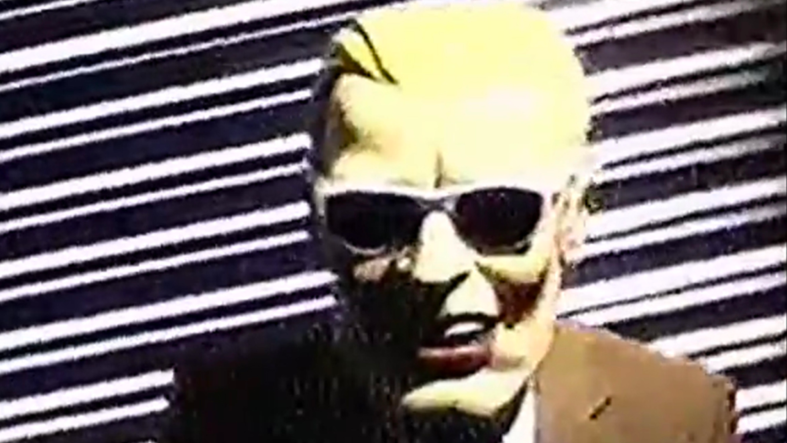November 22 Needs to be Found Footage Day

The Max Headroom Incident occurred on November 22, 1987. For the unfamiliar, two or more people (the popular theory is it was three people) hijacked the WGN-TV feed in Chicago, Illinois for 30 seconds. During a sports recap on the 9 O’Clock Evening News, a person in a Max Headroom mask danced/bobbed their head for 16 seconds in front of a sheet of slowly rocking corrugated metal sheet.
Two hours later the same (?) people hijacked the WTTW-TV feed in Chicago, Illinois. This time the pirates took over a Doctor Who episode, “The Horror of Fang Rock,” for nearly a minute and a half. The second hijacking included audio. And a bare ass. And a flyswatter. Plus possibly a dildo.
The hijacking (or signal intrusion depending on your preferred SEO) has haunted, fascinated, and delivered an immense amount of joy and theorizing since originally uploaded to YouTube by Rick Klein, President and Chief Curator of the Museum of Classic Chicago Television, and its website, fuzzymemories.tv on October 4, 2006. The Fuzzy Memories tag in the YouTube video comes from the original upload, something that needs to be mentioned especially when the video is consistently reuploaded to YouTube and ‘credited’ to others).
Also Read: ‘[REC]’ Reinvented What Found Footage Horror Could Be
If you’re fascinated by this, and since you’re still reading you’re probably interested in this, there’s a must-read piece published by Vice from 2013, “The Mystery of the Creepiest Television Hack,” an update of sorts in 2018, a really good episode of the Stuff You Should Know podcast about the hack in 2018 and, maybe most important for those ready to go down the rabbit hole, a massive Reddit thread on the potential culprits. There are literally hundreds of hours of podcasts, radio stories, and YouTube videos about these combined two minutes of television. The Max Headroom Incident is the Minor Threat or Joy Division of hacking and found footage. The output may be minimal but the influence is inescapable.
At this point, the folks behind it will most likely remain unidentified forever. There was an FBI investigation that yielded nothing of note. The statute of limitations for prosecution expired after five years. There’s a large group of Max Headroom hack enthusiasts that believe if the perpetrators ever did reveal themselves with proof they’d be urban legends. But it’s been over 35 years since that fateful, almost lost-to-history night in the Chicagoland viewing area. It’s looking like the criminals/artists/hackers/pranksters/Maxs are never going to be revealed. So it’s time to stop looking for who did it and begin to honor their contribution to both broadcast intrusion and found footage.
Also Read: ‘Frogman’ Is Cryptid Found Footage Done Right [Review]
The hack is legendary and its story is legendary because they got away with it, but its continued fascination around the internet is also because the two hacks, the original YouTube uploads, are some of the best found footage videos.
If YouTube never becomes YouTube, the Max Headroom Incident is most likely a forgotten footnote in television history, on par with a $1,000-level Jeopardy! question. In order for the incident to maintain fascination decades after its 15 minutes of fame, someone needed to have the wherewithal to upload the original footage. That’s what needs to be celebrated. Its documentation is nearly as impressive as the act of piracy.
Last week Christopher Nolan spoke about the perils of losing media due to streaming. In a conversation with The Washington Post, he said, “There is a danger, these days, that if things only exist in the streaming version they do get taken down, they come and go.” Nolan was speaking about feature-length films that may not be available once their initial run on a platform like Netflix takes them down. He’s right to be concerned.
Also Read: This Shocking Netflix True Crime Documentary Plays Out Like a Found Footage Horror Film
From Academy Award-nominated auteurs to aficionados of all things underground, an appreciation for people like Rick Klein and everyone else saving potentially lost media on YouTube, Vimeo, and the Internet Archive deserves a holiday. Their spotlights on the overlooked corners of film and television have inspired countless of us.
There are two definitions of found footage. When it comes to movies, it’s usually used in reference to horror films like The Blair Witch Project, Paranormal Activity, and V/H/S. It’s a presentation technique, no better or worse than any other. But the original definition, “Pre‐existing film footage appropriated by a filmmaker and used in a way that was not originally intended,” is the Max Headroom incident being uploaded to YouTube. This deserves appreciation.
I was not watching WGN-TV on November 22, 1987. Though I was in the broadcast viewing area and though I did watch WGN, I was only a four-year-old and not awake in the 9 PM hour. Same with WTTW-TV two hours later. But I have watched the Max Headroom Incident possibly over a hundred times. And I’ll most likely view it another few hundred times, trying to figure out just what ‘Max’ meant when he (?) says, “Your love is fading!” Thanks to Klein and others like him, the incident will never fade.
Categorized:Editorials

